Mill machinery glossary
By
Wikipedia,
the free encyclopedia,
http://en.wikipedia.org/wiki/Mill_machinery
Become a member of TranslationDirectory.com at just
$12 per month (paid per year)
Advertisements:
Use the search bar to look for terms in all glossaries, dictionaries, articles and other resources simultaneously
This article covers the various different major pieces of mill machinery to be found in windmills, watermills and horse mills. It does not cover machinery found in modern factories.[1] [2]
Watermill machinery
- Axle
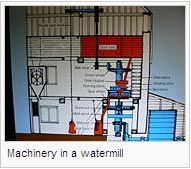 The
axle carries the waterwheel. It can
also carry the Pit Wheel at its opposite end. The
axle carries the waterwheel. It can
also carry the Pit Wheel at its opposite end.
- Bedstone
The Bedstone is the bottom of a pair of millstones. It does not move. The upper stone is called the Runner Stone.
- Crown Wheel
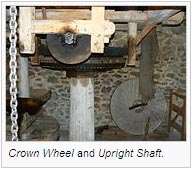 The
Crown Wheel is a driving wheel located at the
top of the Upright Shaft The
Crown Wheel is a driving wheel located at the
top of the Upright Shaft
- Great Spur Wheel
The Great Spur Wheel is a large gear attached to the Upright Shaft. It drives one or more Stone Nuts in a corn mill. If mounted on a Layshaft it is called a Spur Wheel and only drives one Stone Nut
- Layshaft
A Layshaft in a watermill is a horizontal shaft, carrying a Wallower and one or more Spur Wheels. The term can also refer to a minor shaft driving machinery by pulleys and belts.
- Overdrift
Millstones driven from above are known as Overdrift stones.
- Pit Wheel
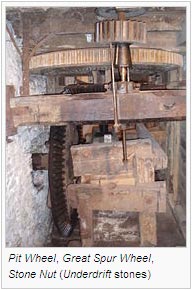 The
Pit Wheel is mounted on the opposite end of
the axle to the waterwheel. It drives
the Wallower on the Upright Shaft or
Layshaft. The
Pit Wheel is mounted on the opposite end of
the axle to the waterwheel. It drives
the Wallower on the Upright Shaft or
Layshaft.
- Rim Drive
Some waterwheels have a rack attached to the circumference, which drives the mill via a pinion mounted on a separate axle, which has a Pit Wheel at its opposite end. This is known as Rim Drive.
- Runner Stone
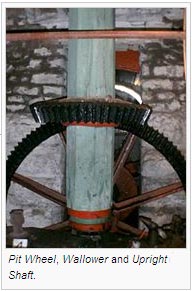 The Runner Stone is the topmost of a pair of millstones. It is driven by the Stone Nut. The lower stone is called a Bedstone. The Runner Stone is the topmost of a pair of millstones. It is driven by the Stone Nut. The lower stone is called a Bedstone.
- Stone Nut
A Stone Nut is a small gear driven by the Great Spur Wheel or Spur Wheel. It drives the Runner Stone. In most watermills, the stones are driven from below. These are called Underdrift stones. A few watermills drove the stones from above, known as Overdrift stones.
- Underdrift
Millstones driven from beneath are known as Underdrift stones.
- Upright Shaft
The Upright Shaft in the main driven shaft in a watermill. It carries the wallower, Great Spur Wheel and sometimes a Crown Wheel.
- Wallower
The Wallower is a small gear at the base of the upright shaft in a watermill, it is driven by the Pit Wheel.
- Waterwheel
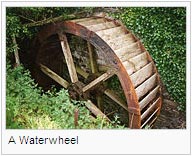 A
waterwheel
is the source of power for a watermill. It is mounted
on the axle and drives the mill by a Pit
Wheel or Rim Drive. A
waterwheel
is the source of power for a watermill. It is mounted
on the axle and drives the mill by a Pit
Wheel or Rim Drive.
Windmill machinery
- Bedstone
The Bedstone is the bottom of a pair of millstones. It does not move. The upper stone is called the Runner Stone.
- Brake Wheel
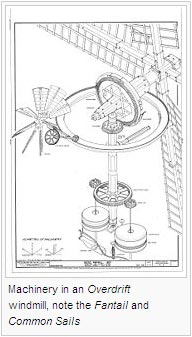 The
Brake Wheel is the main driving wheel in a
Smock
or Tower
mill, and in some post
mills. It is carried on the Windshaft and
drives the Wallower on the Upright Shaft The
Brake Wheel is the main driving wheel in a
Smock
or Tower
mill, and in some post
mills. It is carried on the Windshaft and
drives the Wallower on the Upright Shaft
- Buck
The Buck is an East-Anglian term for the body of a post-mill.
- Crown Tree
The Crown Tree is the central, single baulk of timber, usually oak, that rests on top of the post in a post mill. Attached to it are the side-girts and the rest of the frame of the buck.
- Fantail
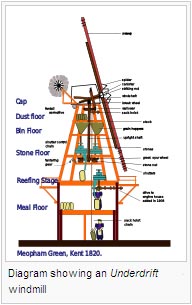 A
fantail
is a small windmill which is used to keep a windmill
facing into the wind automatically. A
fantail
is a small windmill which is used to keep a windmill
facing into the wind automatically.
- Great Spur Wheel
The Great Spur Wheel is carried on the Upright Shaft It drives the Stone Nuts. Millstones driven by the Great Spur Wheel can be either Overdrift or Underdrift.
- Head Wheel
The Head Wheel is carried on the Windshaft in a Post Mill and has a brake around its circumference. It drives a Stone Nut, Millstones driven by the Head Wheel are always Overdrift stones.
- Middling
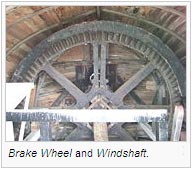 See
Stock See
Stock
- Overdrift
Millstones driven from above are known as Overdrift stones.
- Pintle
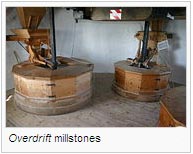 The
pivot centering a post mill on top of the main post. The
pivot centering a post mill on top of the main post.
- Runner Stone
The Runner Stone is the topmost of a pair of millstones. It is driven by the Stone Nut. The lower stone is called a Bedstone.
Sails
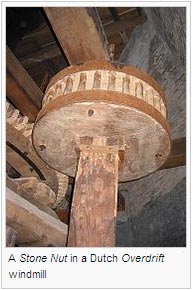 The
Sails are the source of power in a windmill.
They are carried on the Windshaft. Most windmills
had four sails, although some had five (Boston),
six (Waltham,
Lincs) or eight sails Heckington,
Lincs and there is one recorded twelve sailed
windmill (Cottenham,
Cambs). The
Sails are the source of power in a windmill.
They are carried on the Windshaft. Most windmills
had four sails, although some had five (Boston),
six (Waltham,
Lincs) or eight sails Heckington,
Lincs and there is one recorded twelve sailed
windmill (Cottenham,
Cambs).
Common Sails have a lattice framework over which a sailcloth is spread. These were the earliest type of sails in northern European windmills.
Spring Sails, invented in 1772 by Andrew Meikle, have shutters adjusted by a spring. Each sail is adjusted individually and, as with Common Sails the mill has to be stopped to enable an adjustment to be made.
Roller Reefing Sails, invented in 1789 by Stephen Hooper, use a canvas strip wound around a roller in the place of shutters. The mill does not have to be stopped in order to adjust the sails.
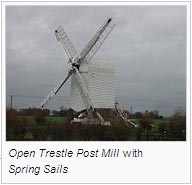 Patent Sails, invented in 1819 by William Cubitt, combine the shutters of the Spring Sail with the automatic adjustment of the Roller Reefing Sail. Single Patents have shutters on the trailing side of the sail, Double Patents have shutters on both sides of the sail for its whole length. Patent Sails, invented in 1819 by William Cubitt, combine the shutters of the Spring Sail with the automatic adjustment of the Roller Reefing Sail. Single Patents have shutters on the trailing side of the sail, Double Patents have shutters on both sides of the sail for its whole length.
- Samson Head
An iron collar and plate bearing that fits over the pintle of a post-mill's post, that supports the weight of the crown tree, around which the buck of the mill is constructed. An example is visible at High Salvington windmill.
- Stock
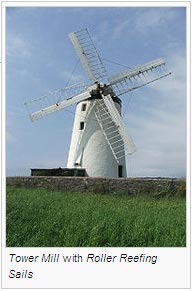 The
beam that passes through the canister of the windshaft,
which the sails are bolted onto. The
beam that passes through the canister of the windshaft,
which the sails are bolted onto.
- Stone Nut
The Stone Nut is a small gear driven by the Great Spur Wheel, Head Wheel, or Tail Wheel. It drives the Runner Stone either from above (Overdrift) or below (Underdrift).
- Tail Wheel
The Tail Wheel is carried on the Windshaft in a Post Mill and drives a Stone Nut. Millstones driven by the Tail Wheel are always Overdrift stones.
- Trestle
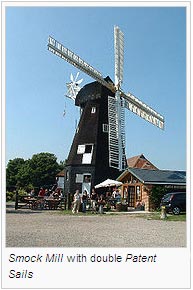 The
Trestle
is the substructure of a Post Mill, usually enclosed
in a protective structure called a roundhouse, which
also serves as a storage facility. Post mills without
a roundhouse are called Open Trestle Post Mills. The
Trestle
is the substructure of a Post Mill, usually enclosed
in a protective structure called a roundhouse, which
also serves as a storage facility. Post mills without
a roundhouse are called Open Trestle Post Mills.
- Underdrift
Millstones driven from beneath are known as Underdrift stones.
- Upright Shaft
The Upright Shaft is the main vertical shaft found in Smock and Tower mills. It is also found in some Post mills. It carries the Wallower at its top end, and a Great Spur Wheel at the bottom end. The Great Spur Wheel drves two or more Stone nuts.
- Wallower
The Wallower is a driven gear at the top of the Upright Shaft in Smock, Tower and some Post mills. It is driven by the Brake Wheel
- Windshaft
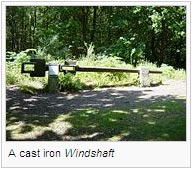 The
Windshaft carries the Sails and also
the Brake Wheel (Smock and Tower mills, and
in some Post mills) or the Head Wheel and Tail
Wheel in a Post Mill. Windshafts can be wholly
made of wood, or wood with a cast iron Poll End (where
the Sails are mounted} or entirely of cast
iron. The
Windshaft carries the Sails and also
the Brake Wheel (Smock and Tower mills, and
in some Post mills) or the Head Wheel and Tail
Wheel in a Post Mill. Windshafts can be wholly
made of wood, or wood with a cast iron Poll End (where
the Sails are mounted} or entirely of cast
iron.
References
- ^ * Reynolds, John (1974). Windmills and Watermills. London: Hugh Evelyn Ltd.. SBN 238.78943.8. covers most entries
- ^ *Freese, Stanley (1957). Windmills & Millwrighting. Newton Abbot: David & Charles. ISBN 0 7153 5365 9. covers Buck, Crown Tree, Pintle, Samson Head
See also
Published - March 2009
This
glossary is available under the terms
of the GNU Free Documentation
Find free glossaries at TranslationDirectory.com
Find free dictionaries at TranslationDirectory.com
Subscribe to free TranslationDirectory.com newsletter
Need more translation jobs from translation agencies? Click here!
Translation agencies are welcome to register here - Free!
Freelance translators are welcome to register here - Free!
Submit your glossary or dictionary for publishing at TranslationDirectory.com
|